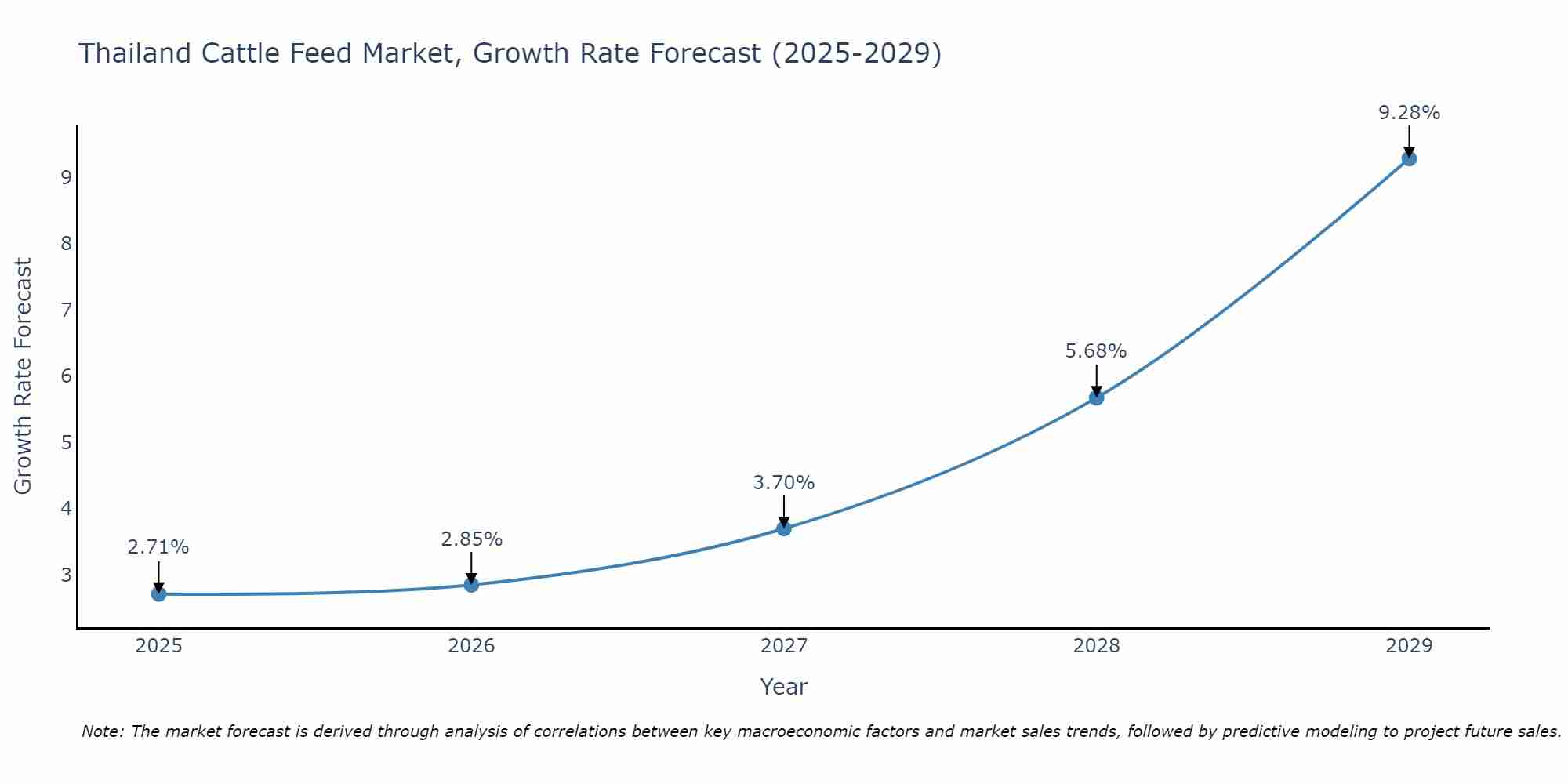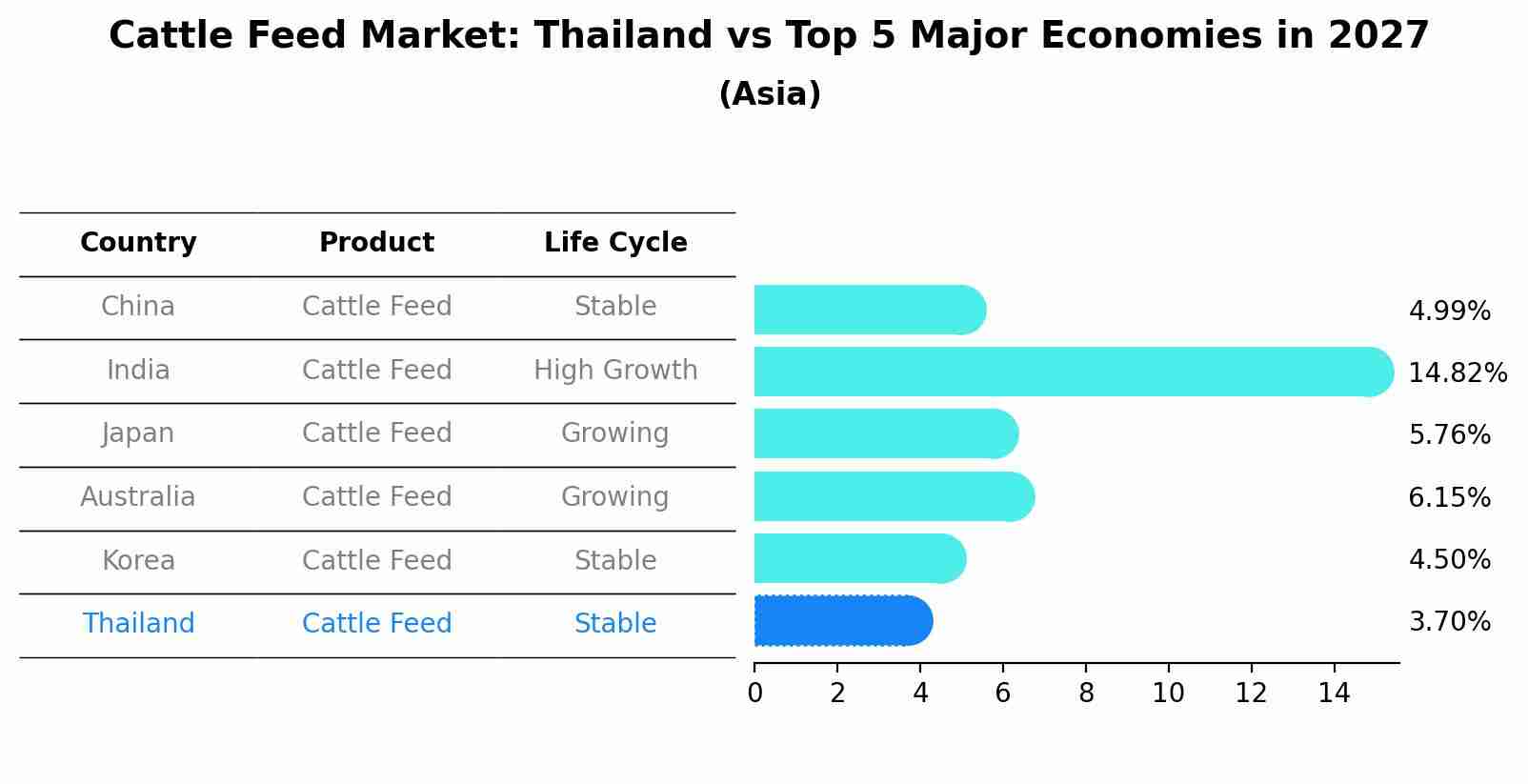Thailand Cattle Feed Market (2025-2031) Outlook | Forecast, Revenue, Analysis, Industry, Share, Companies, Size, Trends, Growth & Value
| Product Code: ETC380785 | Publication Date: Aug 2022 | Updated Date: Apr 2025 | Product Type: Market Research Report | |
| Publisher: 6Wresearch | No. of Pages: 75 | No. of Figures: 35 | No. of Tables: 20 | |
Thailand Cattle Feed Market Size Growth Rate
The Thailand Cattle Feed Market is likely to experience consistent growth rate gains over the period 2025 to 2029. From 2.71% in 2025, the growth rate steadily ascends to 9.28% in 2029.

Cattle Feed Market: Thailand vs Top 5 Major Economies in 2027 (Asia)
The Cattle Feed market in Thailand is projected to grow at a stable growth rate of 3.70% by 2027, within the Asia region led by China, along with other countries like India, Japan, Australia and South Korea, collectively shaping a dynamic and evolving market environment driven by innovation and increasing adoption of emerging technologies.

Thailand Cattle Feed Market Synopsis
The Thailand cattle feed market plays a crucial role in supporting the livestock industry, particularly for beef and dairy production. Cattle farmers rely on various types of cattle feed, including grass, grains, and concentrated feed mixes, to ensure the health and productivity of their herds. The market is influenced by factors such as feed prices, cattle health concerns, and government policies related to agriculture. Sustainable and efficient feed production and distribution are essential to meet the growing demand for cattle products in Thailand.
Drivers of the Market
The Thailand cattle feed market has experienced growth driven by various factors. The country`s livestock and dairy industries have been expanding, necessitating the use of high-quality cattle feed to enhance animal health and productivity. The growing demand for meat and dairy products has led to increased cattle farming, further boosting the need for specialized feed. Additionally, advancements in cattle nutrition research and the development of feed formulations tailored to specific cattle breeds have played a crucial role in market growth. Government support for the agriculture sector has also encouraged investment in the cattle feed industry, promoting its development.
Challenges of the Market
Challenges in the cattle feed market include the need to balance cost-effective feed solutions with meeting the nutritional requirements of cattle. Ensuring the availability and quality of feed ingredients can be impacted by factors such as weather conditions and commodity price fluctuations. Additionally, the market must adapt to changing trends in cattle farming practices and environmental sustainability concerns.
COVID-19 Impact on the Market
The Thailand cattle feed market faced multifaceted challenges during the COVID-19 pandemic. Initially, disruptions in the supply chain, including the availability of raw materials, hampered production. The closure of restaurants and foodservice establishments also impacted the demand for beef, influencing the need for cattle feed. Farmers experienced economic difficulties, affecting their ability to purchase feed. Government support programs played a crucial role in stabilizing the sector. The market`s recovery was closely linked to the reopening of the foodservice industry and the overall economic rebound.
Key Players in the Market
In the Thailand cattle feed market, major players like Charoen Pokphand Group (CP Group), Thai Foods Group, and Cargill Thailand play a pivotal role in supplying cattle feed products to support livestock farming and beef production.
Key Highlights of the Report:
- Thailand Cattle Feed Market Outlook
- Market Size of Thailand Cattle Feed Market, 2024
- Forecast of Thailand Cattle Feed Market, 2031
- Historical Data and Forecast of Thailand Cattle Feed Revenues & Volume for the Period 2021-2031
- Thailand Cattle Feed Market Trend Evolution
- Thailand Cattle Feed Market Drivers and Challenges
- Thailand Cattle Feed Price Trends
- Thailand Cattle Feed Porter's Five Forces
- Thailand Cattle Feed Industry Life Cycle
- Historical Data and Forecast of Thailand Cattle Feed Market Revenues & Volume By Source for the Period 2021-2031
- Historical Data and Forecast of Thailand Cattle Feed Market Revenues & Volume By Organic for the Period 2021-2031
- Historical Data and Forecast of Thailand Cattle Feed Market Revenues & Volume By Conventional for the Period 2021-2031
- Historical Data and Forecast of Thailand Cattle Feed Market Revenues & Volume By Application for the Period 2021-2031
- Historical Data and Forecast of Thailand Cattle Feed Market Revenues & Volume By Agriculture for the Period 2021-2031
- Historical Data and Forecast of Thailand Cattle Feed Market Revenues & Volume By Industrial for the Period 2021-2031
- Historical Data and Forecast of Thailand Cattle Feed Market Revenues & Volume By Sales Channel for the Period 2021-2031
- Historical Data and Forecast of Thailand Cattle Feed Market Revenues & Volume By Direct Sales for the Period 2021-2031
- Historical Data and Forecast of Thailand Cattle Feed Market Revenues & Volume By Indirect Sales for the Period 2021-2031
- Thailand Cattle Feed Import Export Trade Statistics
- Market Opportunity Assessment By Source
- Market Opportunity Assessment By Application
- Market Opportunity Assessment By Sales Channel
- Thailand Cattle Feed Top Companies Market Share
- Thailand Cattle Feed Competitive Benchmarking By Technical and Operational Parameters
- Thailand Cattle Feed Company Profiles
- Thailand Cattle Feed Key Strategic Recommendations
Frequently Asked Questions About the Market Study (FAQs):
- Single User License$ 1,995
- Department License$ 2,400
- Site License$ 3,120
- Global License$ 3,795
Search
Related Reports
- Vietnam System Integrator Market (2025-2031) | Size, Companies, Analysis, Industry, Value, Forecast, Growth, Trends, Revenue & Share
- ASEAN and Thailand Brain Health Supplements Market (2025-2031) | Strategy, Consumer Insights, Analysis, Investment Trends, Opportunities, Growth, Size, Share, Industry, Revenue, Segments, Value, Segmentation, Supply, Forecast, Restraints, Outlook, Competition, Drivers, Trends, Demand, Pricing Analysis, Competitive, Strategic Insights, Companies, Challenges
- ASEAN Bearings Market (2025-2031) | Strategy, Consumer Insights, Analysis, Investment Trends, Opportunities, Growth, Size, Share, Industry, Revenue, Segments, Value, Segmentation, Supply, Forecast, Restraints, Outlook, Competition, Drivers, Trends, Demand, Pricing Analysis, Competitive, Strategic Insights, Companies, Challenges
- Europe Flooring Market (2025-2031) | Outlook, Share, Industry, Trends, Forecast, Companies, Revenue, Size, Analysis, Growth & Value
- Saudi Arabia Manlift Market (2025-2031) | Outlook, Size, Growth, Trends, Companies, Industry, Revenue, Value, Share, Forecast & Analysis
- Uganda Excavator, Crane, and Wheel Loaders Market (2025-2031) | Strategy, Consumer Insights, Analysis, Investment Trends, Opportunities, Growth, Size, Share, Industry, Revenue, Segments, Value, Segmentation, Supply, Forecast, Restraints, Outlook, Competition, Drivers, Trends, Demand, Pricing Analysis, Competitive, Strategic Insights, Companies, Challenges
- Rwanda Excavator, Crane, and Wheel Loaders Market (2025-2031) | Strategy, Consumer Insights, Analysis, Investment Trends, Opportunities, Growth, Size, Share, Industry, Revenue, Segments, Value, Segmentation, Supply, Forecast, Restraints, Outlook, Competition, Drivers, Trends, Demand, Pricing Analysis, Competitive, Strategic Insights, Companies, Challenges
- Kenya Excavator, Crane, and Wheel Loaders Market (2025-2031) | Strategy, Consumer Insights, Analysis, Investment Trends, Opportunities, Growth, Size, Share, Industry, Revenue, Segments, Value, Segmentation, Supply, Forecast, Restraints, Outlook, Competition, Drivers, Trends, Demand, Pricing Analysis, Competitive, Strategic Insights, Companies, Challenges
- Angola Excavator, Crane, and Wheel Loaders Market (2025-2031) | Strategy, Consumer Insights, Analysis, Investment Trends, Opportunities, Growth, Size, Share, Industry, Revenue, Segments, Value, Segmentation, Supply, Forecast, Restraints, Outlook, Competition, Drivers, Trends, Demand, Pricing Analysis, Competitive, Strategic Insights, Companies, Challenges
- Israel Intelligent Transport System Market (2025-2031) | Strategy, Consumer Insights, Analysis, Investment Trends, Opportunities, Growth, Size, Share, Industry, Revenue, Segments, Value, Segmentation, Supply, Forecast, Restraints, Outlook, Competition, Drivers, Trends, Demand, Pricing Analysis, Competitive, Strategic Insights, Companies, Challenges
Industry Events and Analyst Meet
Our Clients
Whitepaper
- Middle East & Africa Commercial Security Market Click here to view more.
- Middle East & Africa Fire Safety Systems & Equipment Market Click here to view more.
- GCC Drone Market Click here to view more.
- Middle East Lighting Fixture Market Click here to view more.
- GCC Physical & Perimeter Security Market Click here to view more.
6WResearch In News
- Doha a strategic location for EV manufacturing hub: IPA Qatar
- Demand for luxury TVs surging in the GCC, says Samsung
- Empowering Growth: The Thriving Journey of Bangladesh’s Cable Industry
- Demand for luxury TVs surging in the GCC, says Samsung
- Video call with a traditional healer? Once unthinkable, it’s now common in South Africa
- Intelligent Buildings To Smooth GCC’s Path To Net Zero













